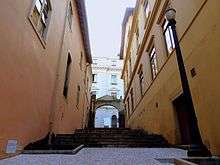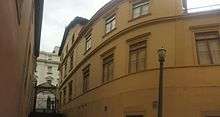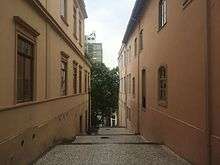Beco do Pinto

The Beco do Pinto, also known as Beco do Colégio, is a it's a passage located between the Casa Número Um and Solar da Marquesa de Santos in the Center of São Paulo. Actually, links the streets Roberto Simonsen and Bitterncourt Rodrigues. But, in the colonial times from Brazil, had the function of allow the transit of people and animal between the "Largo da Sé" to the meadow of Tamanduateí River. Today, under the administration of "Casa da Imagem" (also known as "Casa Número Um"), houses projects especially developed for the space by contemporary artists. Also constitutes an important architectural, historical and cultural sets, together with buildings that that surround it, and integrates the Museu da Cidade de São Paulo.[1]
History

Nomeation
The alley received the name "Beco do Pinto" for this being the last name from the Brigadeiro José Joaquim Pinto de Moraes Leme. In 1821, the military, then owner of the sobrado - a house that later came to be known as Solar da Marquesa de Santos - made the first significant change in relation to the passage and began a complicated relationship with the Câmara Municipal.[2]
In addition to being a way of strategical communication that linked the higher part of the city with the lower part, where were concentrated the trades of São Paulo, the Alley also was a path where the slaves went to fetch water and discard domestic dump. And, for being a steep and winding passage, a lot chooses to not goes down until the meadow, and dumped the trash wherever they went. Troubled with it, the Brigadeiro closed the Beco do Pinto with a gate. But this change didn't last very much, because the order was contested and forbidden by the City Hall, because it was a public servitude.[2]
José Joaquim Pinto was again notified a few years later, that time, for having expanded his back yard with the construction of a wall. The change would have harmed the insulation from the neighboring house, today the Casa Número Um. The wall was demolished in 1826.[3] And the passage was reopened by the City Hall, receivem the official name of Beco do Colégio.[2]
Marquesa de Santos
Domitila de Castro Canto e Melo, the Marquesa de Santos, bought the Solar in 1834. Together with the purchase, came came the requirement that the City Hall allowed the reconstruction of the demolished wall and the re-installation from the Beco's gate, alleging that there would be no guarantee of security to their property without the taking of such measures. In 1849, the solicitation was attended by the City Halll.[4]
Currently
In 1912, after the opening from the slope of Carmo, actual Avenue Rangel Pestana, the Beco lost it's function and was definitely deactivated.[5]

Currently, the Beco do Pinto is under the responsibility of the Secretaria Municipal de Cultura, is administered by Casa da Imagem, integrates the Museu da Cidade de São Paulo and houses artistic installations produced only for this space.[4]
Architectural Features
The Beco do Pinto was constructed, originally, so that the walk was possible between the old street of Carmo - today, street Roberto Simonsen - and the meadow of Tamanduateí river (near the actual street Bittencourt Rodrigues), places separated by a great slope.
In that way, is configured architecturally on a staircase permeated by bids, which alternate between flat and inclined. The steps are made of granite and the flat throws are covered with Portuguese stones. The lateral boundaries are defined by the lots of neighboring buildings, the Casa Número Um (current Casa da Imagem) and the Solar da Marquesa de Santos.
The Beco is sited in a ground of 368,40 m² and have two extremities marked by gates with boss and triangular pediment. The gate from the Roberto Simonsen street presents neoclassic's ornaments, aduela and the coat of arms of Brazil, in low relief. In addition, there are two archaeological showcases that exhibit vestiges of the old footwear.[6]

Cultural and Historical significance
The Beco do Pinto marks the linking between two buildings of exceptional historical value for the city of São Paulo: the Solar da Marquesa de Santos and the Casa Número Um. Beyond that, the passage also represents an important historical mark for having been, during the years from the Brazilian colonial age, the main link between the urban center, concentrated around thePátio do Colégio, and the Tamanduateí river, located where there was a commercial grouping.[4]

Tumbing
The conservation from Beco do Pinto is protected by the Decree nº 26.818, from September 09, 1988, realized during the Prefecture of Jânio Quadros in São Paulo. It determines the preservation of goods located inside the perimeter of Pátio do Colégio, in the Center of the municipality.[7]
Actual state
Today, having lost its passage function, the Beco wins an artistic value. Since 2011, artists have been creating installations specifically for the place. The first was made by Laura Vinci, what, with an work that released vapors, reflected about the passing of the time.[8]
Gallery
 View from the Beco since the lower part
View from the Beco since the lower part View from theBeco since the higher part
View from theBeco since the higher part Glass detail betwenn the stairways of Beco do Pinto
Glass detail betwenn the stairways of Beco do Pinto Artistic presentation in the middle of Beco do Pinto in 2013 [9]
Artistic presentation in the middle of Beco do Pinto in 2013 [9]
References
- ↑ "Museu da Cidade de São Paulo - Beco do Pinto". www.museudacidade.sp.gov.br. Retrieved 2016-11-23.
- 1 2 3 "Museu da Cidade de São Paulo - Beco do Pinto". www.museudacidade.sp.gov.br. Retrieved 2016-11-23.
- ↑ SANT’ANNA, Nuto (1936). O Beco do Colégio (1554-1935). Revista do Arquivo do Municipal. pp. 5–74.
- 1 2 3 DPH, Relatório de Bens Protegidos do Departamento de Patrimônio Histórico de São Paulo. Beco do Pinto. Acessado em 29 de outubro de 2016
- ↑ "Museu da Cidade de São Paulo - Beco do Pinto". www.museudacidade.sp.gov.br. Retrieved 2016-11-23.
- ↑ DPH, Relatório de Bens Protegidos do Departamento de Patrimônio Histórico de São Paulo. Beco do Pinto. Acessado em 29 de outubro de 2016
- ↑ Prefeitura do Município de São Paulo, Secretaria Municipal da Cultura - Departamento do Patrimônio Histórico. Decreto nº 26.818. Disponível em: http://www.prefeitura.sp.gov.br/cidade/upload/fc9d9_Decreto_26818_T_Imoveis_Pateo_do_Colegio.pdf
- ↑ "Centro novo". Divirta-se.
- ↑ https://culturaefutebol.wordpress.com/2013/05/19/exposicao-rubens-mano-corte-e-retencao-na-casa-da-imagem/